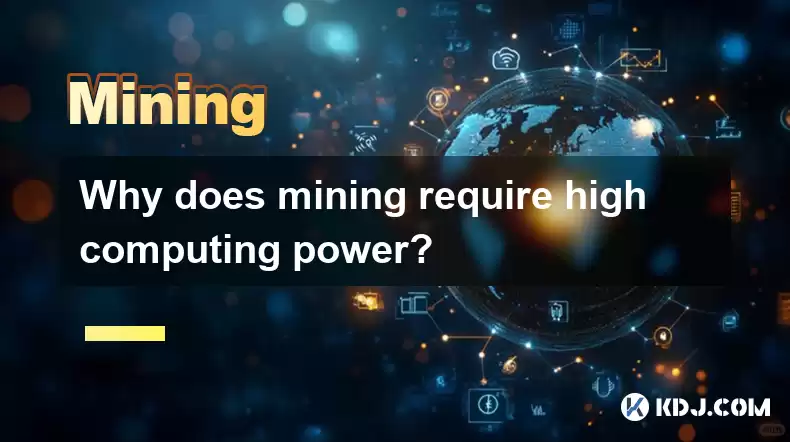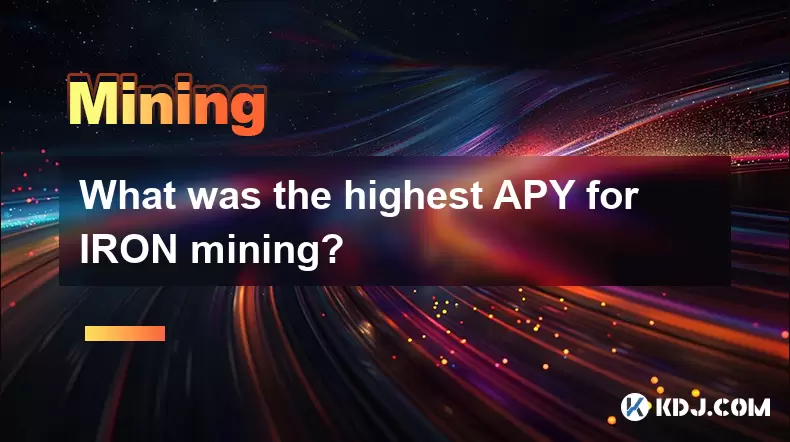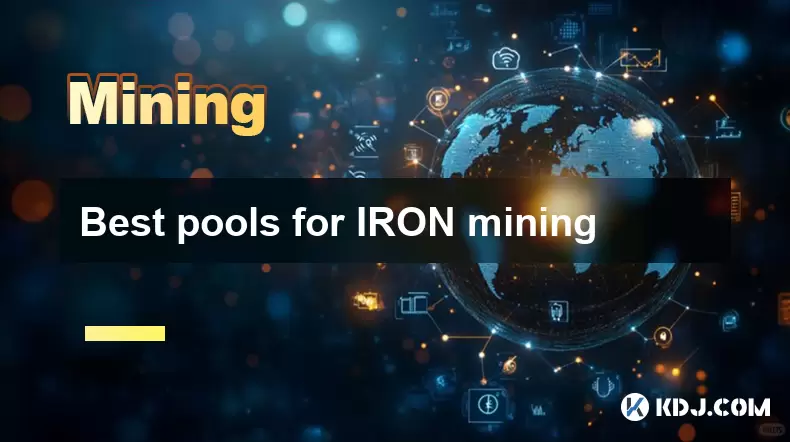-
 Bitcoin
Bitcoin $118000
0.67% -
 Ethereum
Ethereum $3750
0.71% -
 XRP
XRP $3.183
1.61% -
 Tether USDt
Tether USDt $1.000
-0.01% -
 BNB
BNB $788.1
1.21% -
 Solana
Solana $186.0
0.85% -
 USDC
USDC $0.9999
-0.02% -
 Dogecoin
Dogecoin $0.2373
1.25% -
 TRON
TRON $0.3204
1.76% -
 Cardano
Cardano $0.8266
1.85% -
 Hyperliquid
Hyperliquid $44.04
1.28% -
 Sui
Sui $4.192
5.88% -
 Stellar
Stellar $0.4399
2.63% -
 Chainlink
Chainlink $18.40
1.19% -
 Hedera
Hedera $0.2842
9.06% -
 Bitcoin Cash
Bitcoin Cash $560.5
2.46% -
 Avalanche
Avalanche $24.99
4.58% -
 Litecoin
Litecoin $114.5
1.25% -
 UNUS SED LEO
UNUS SED LEO $8.980
-0.03% -
 Shiba Inu
Shiba Inu $0.00001406
0.53% -
 Toncoin
Toncoin $3.306
4.27% -
 Ethena USDe
Ethena USDe $1.001
0.03% -
 Polkadot
Polkadot $4.169
2.37% -
 Uniswap
Uniswap $10.56
1.95% -
 Monero
Monero $322.8
1.06% -
 Dai
Dai $0.0000
0.00% -
 Bitget Token
Bitget Token $4.545
0.12% -
 Pepe
Pepe $0.00001261
1.29% -
 Aave
Aave $296.5
1.27% -
 Cronos
Cronos $0.1379
5.90%
マイニングには高いコンピューティングパワーが必要なのはなぜですか?
Bitcoinマイニングの高いコンピューティング需要は、環境上の懸念にもかかわらず、複雑な数学の問題、ハッシュ機能、難易度の調整、経済的インセンティブ、セキュリティのニーズに由来しています。
2025/04/16 12:07

暗号通貨の世界での採掘、特にBitcoinおよびその他の仕事の証明(POW)暗号通貨の場合、重要な計算リソースを要求するプロセスです。この記事では、コンピューティングパワーに対するこの高い需要の背後にある理由を掘り下げ、技術的な複雑さとそのようなリソースを必要とする根本的な原則を探ります。
暗号通貨採掘の基本
暗号通貨マイニングには、複雑な数学的問題を解決してトランザクションを検証し、ブロックチェーンに追加することが含まれます。このプロセスは、ブロックチェーンの完全性とセキュリティを維持するために重要です。鉱夫はこれらの問題を解決するために競争し、最初にそうすることはブロックチェーンに新しいブロックを追加し、新しく造られた暗号通貨で報われます。
これらの問題の複雑さは、高いコンピューティングパワーの必要性を促進するものです。各問題は、解決が難しいが検証が容易になるように設計されており、ソリューションが見つかったら、ネットワークによってすぐに確認できるようにします。
ハッシュ関数の役割
鉱業の中心には、ハッシュ関数の使用があります。ハッシュ関数は入力(または「メッセージ」)を取り、通常、ハッシュテーブルのデータのインデックスを作成するために使用される固定サイズのバイト文字列を返します。マイニングのコンテキストでは、鉱夫はハッシュ関数を使用して、トランザクションデータやその他の情報を含むブロックのヘッダーのハッシュを作成します。
Bitcoinで使用されるハッシュ関数、SHA-256は、計算集中的に設計されています。必要な基準(つまり、特定のターゲット値を下回るハッシュ)を満たすハッシュを生成するために、重要な処理能力が必要です。このターゲット値は、一貫したブロック時間を維持するために定期的に調整されます。これは、Bitcoinの場合は約10分です。
難易度調整メカニズム
難易度調整メカニズムは、高いコンピューティングパワーの必要性を促進する重要な要素です。このメカニズムは、ネットワークの総計算能力に基づいて、マイニング問題の難しさを調整します。より多くのマイナーがネットワークに参加し、総ハッシュレートが上昇すると、ブロック時間が一貫していることを保証するために困難が増加します。
逆に、鉱夫がネットワークを離れ、ハッシュレートが低下すると、難易度が低下します。この動的な調整により、ブロックチェーンが安全なままであり、新しいブロック作成の速度が安定したままであることが保証されますが、マイナーは競争力を維持するためにハードウェアを継続的にアップグレードする必要があります。
高いコンピューティングパワーの経済的インセンティブ
鉱夫が高出力機器を使用する経済的インセンティブは、重要なコンピューティングリソースの必要性の背後にあるもう1つの原動力です。鉱山労働者は、採掘に成功した各ブロックごとに暗号通貨で報われ、機器がより強力なほど、問題を最初に解決し、報酬を請求する可能性が高くなります。
この報酬のための競争は、鉱業ハードウェアの武器競争につながり、鉱夫は常により効率的で強力な機器を求めています。これには、マイニング専用に設計されたアプリケーション固有の統合回路(ASIC)などの特殊なハードウェアが含まれ、汎用ハードウェアよりもはるかに高い効率を提供します。
高いコンピューティングパワーのセキュリティへの影響
マイニングに必要な高いコンピューティングパワーは、ブロックチェーンのセキュリティにおいて重要な役割を果たします。マイニングに専念するコンピューティングパワーが多いほど、単一のエンティティがネットワークのハッシュレートの大部分を制御するのが難しくなります。これは、51%の攻撃を開始するために必要です。
51%の攻撃には、攻撃者がネットワークのマイニングパワーの半分以上を制御し、ブロックチェーンを操作できるようにします。高いコンピューティングパワー要件により、このような攻撃は非常に困難で費用がかかり、それによりネットワークのセキュリティが強化されます。
高いコンピューティングパワーの環境への影響
マイニングにおける高いコンピューティングパワーの必要性は、その環境への影響についての懸念も高めています。鉱業作業は、炭素排出量やその他の環境問題に貢献して、かなりの量の電力を消費します。これにより、POW暗号通貨の持続可能性と、同じレベルのコンピューティングパワーを必要としないSporm of Stake(POS)などの代替コンセンサスメカニズムの探求についての議論につながりました。
ただし、これらの懸念にもかかわらず、高いコンピューティングパワー要件は、鉱山労働者を動機付けるブロックチェーンと経済的インセンティブを確保する必要性によって推進され、POW暗号通貨の基本的な側面のままです。
よくある質問
Q:通常のコンピューターでマイニングを行うことはできますか?
A:通常のコンピューターを使用して暗号通貨をマイニングすることは技術的には可能ですが、難易度が高いため、必要な特殊なハードウェアが必要であるため、実用的または収益性はありません。通常のコンピューターには、ASICやその他の特殊なマイニング機器と競合するために必要な処理能力と効率がありません。
Q:マイニングの難易度は、ブロックをマイニングするのにかかる時間にどのように影響しますか?
A:マイニングの難易度は、ブロックをマイニングするのにかかる時間に直接影響します。難易度が高いということは、有効なハッシュを見つけるためにより多くの計算努力が必要であることを意味します。これにより、ブロックをマイニングするのにかかる時間が長くなります。逆に、難易度が低くなると、必要な計算努力が減少し、ブロックをマイニングする時間を短縮する可能性があります。 Bitcoinの10分間のターゲットなど、ターゲットブロック時間を維持するために、難易度が定期的に調整されます。
Q:マイニングに高いコンピューティングパワーを必要としない暗号通貨はありますか?
A:はい、一部の暗号通貨では、高いコンピューティングパワーを必要としない代替コンセンサスメカニズムを使用しています。たとえば、Ethereum 2.0(その移行後)のような株式(POS)の証明(POS)の暗号通貨は、保持しているコインの数に基づいて新しいブロックを作成するために選択され、計算能力ではなく担保として「利害関係」になることを望んでいます。
Q:鉱山労働者はどのようにして事業の環境への影響を減らすことができますか?
A:マイナーは、再生可能エネルギー源を使用して操作を強化し、ハードウェアのエネルギー効率を改善し、カーボンオフセットプログラムに参加するなど、環境への影響を軽減するためにいくつかの措置を講じることができます。一部の鉱業作業は、二酸化炭素排出量を最小限に抑えるために、豊富な再生可能エネルギー資源のある地域にもあります。
免責事項:info@kdj.com
提供される情報は取引に関するアドバイスではありません。 kdj.com は、この記事で提供される情報に基づいて行われた投資に対して一切の責任を負いません。暗号通貨は変動性が高いため、十分な調査を行った上で慎重に投資することを強くお勧めします。
このウェブサイトで使用されているコンテンツが著作権を侵害していると思われる場合は、直ちに当社 (info@kdj.com) までご連絡ください。速やかに削除させていただきます。
- Tron ETF、ステーキング報酬、および制度的資本:TRXの新しい時代?
- 2025-07-27 12:50:13
- ビットコインリザーブ、価格、およびハイパーアップ:暗号波に乗って100万ドルになりますか?
- 2025-07-27 12:55:12
- スマートマネーの動き:ウォレットの撤退、SPXの蓄積、そしてそれが何を意味するのか
- 2025-07-27 12:30:12
- Ethereum、Justin Sun、およびMarket憶測:暗号カクテル
- 2025-07-27 12:30:12
- 2025年7月のミームコイン:ビットコインは後部座席を取りますか?
- 2025-07-27 10:30:12
- Hifi Price Eyes Breakout:十字線の下降トレンドライン?
- 2025-07-27 10:30:12
関連知識

鉄の採掘の最高のAPYは何でしたか?
2025-07-23 05:14:36
鉄のトークンとそのマイニングメカニズムを理解するアイアントークンは、主にポリゴンやバイナンススマートチェーンなどのブロックチェーンネットワークで、鉄の金融エコシステム内で動作するスタブコインです。部分的な担保モデルを通じて、米ドルで1:1ペグを維持するように設計されています。完全に裏打ちされたスチュ...

鉄のプールでの非永続的損失とは何ですか?
2025-07-23 09:00:41
鉄プールの文脈における非永続的な損失を理解する非永続的な損失は、分散型ファイナンス(DEFI)プラットフォーム、特に自動マーケットメーカー(AMM)モデルを利用しているプラットフォームの流動性プロバイダーに影響を与える現象です。鉄の金融エコシステムの一部である鉄プールのコンテキストでは、堆積した資産...

鉄の採掘から報酬を請求する方法は?
2025-07-23 14:21:39
鉄の採掘と報酬メカニズムの理解Iron Financeは、ポリゴンおよびバイナンススマートチェーンネットワークで分散型ファイナンス(DEFI)プロトコルとして機能し、鉄とタイタンで構成されるデュアルトークンシステムを導入しました。このプロトコルにより、ユーザーは指定されたプールに資産を提供することに...

初心者向けの鉄採掘チュートリアル
2025-07-27 00:01:13
鉄とは何ですか、そしてそれは暗号通貨のエコシステムでどのように機能しますか? Ironは、Binance Smart Chain(BSC)で動作する暗号通貨トークンであり、過剰な資産を通じてStablecoinソリューションを提供するように設計された分散型ファイナンス(DEFI)プロトコルの一部です...

ポリゴンで鉄の採掘を開始する方法は?
2025-07-23 20:00:37
ポリゴンでの鉄とその役割を理解する鉄は、米ドルで1:1のペグを維持するように設計された分散型のアルゴリズムの安定性です。ポリゴン(以前のMatic Network)を含む複数のブロックチェーンネットワークで動作します。これは、低い取引手数料と高スループットを提供します。フィアットリザーブに裏打ちされ...

鉄の採掘に最適なプール
2025-07-26 03:56:42
鉄の採掘とそのユニークなメカニズムを理解するIron(Iron Finance)は、マルチチェーンアルゴリズムのStablecoinエコシステムの作成を目的とした分散型ファイナンス(DEFI)プロジェクトでした。元の鉄のトークンは、銀行の運営により2021年半ばに崩壊しましたが、さまざまなブロックチ...

鉄の採掘の最高のAPYは何でしたか?
2025-07-23 05:14:36
鉄のトークンとそのマイニングメカニズムを理解するアイアントークンは、主にポリゴンやバイナンススマートチェーンなどのブロックチェーンネットワークで、鉄の金融エコシステム内で動作するスタブコインです。部分的な担保モデルを通じて、米ドルで1:1ペグを維持するように設計されています。完全に裏打ちされたスチュ...

鉄のプールでの非永続的損失とは何ですか?
2025-07-23 09:00:41
鉄プールの文脈における非永続的な損失を理解する非永続的な損失は、分散型ファイナンス(DEFI)プラットフォーム、特に自動マーケットメーカー(AMM)モデルを利用しているプラットフォームの流動性プロバイダーに影響を与える現象です。鉄の金融エコシステムの一部である鉄プールのコンテキストでは、堆積した資産...

鉄の採掘から報酬を請求する方法は?
2025-07-23 14:21:39
鉄の採掘と報酬メカニズムの理解Iron Financeは、ポリゴンおよびバイナンススマートチェーンネットワークで分散型ファイナンス(DEFI)プロトコルとして機能し、鉄とタイタンで構成されるデュアルトークンシステムを導入しました。このプロトコルにより、ユーザーは指定されたプールに資産を提供することに...

初心者向けの鉄採掘チュートリアル
2025-07-27 00:01:13
鉄とは何ですか、そしてそれは暗号通貨のエコシステムでどのように機能しますか? Ironは、Binance Smart Chain(BSC)で動作する暗号通貨トークンであり、過剰な資産を通じてStablecoinソリューションを提供するように設計された分散型ファイナンス(DEFI)プロトコルの一部です...

ポリゴンで鉄の採掘を開始する方法は?
2025-07-23 20:00:37
ポリゴンでの鉄とその役割を理解する鉄は、米ドルで1:1のペグを維持するように設計された分散型のアルゴリズムの安定性です。ポリゴン(以前のMatic Network)を含む複数のブロックチェーンネットワークで動作します。これは、低い取引手数料と高スループットを提供します。フィアットリザーブに裏打ちされ...

鉄の採掘に最適なプール
2025-07-26 03:56:42
鉄の採掘とそのユニークなメカニズムを理解するIron(Iron Finance)は、マルチチェーンアルゴリズムのStablecoinエコシステムの作成を目的とした分散型ファイナンス(DEFI)プロジェクトでした。元の鉄のトークンは、銀行の運営により2021年半ばに崩壊しましたが、さまざまなブロックチ...
すべての記事を見る

























































































